|
Modern firelighting methods
MATCHES
This method is considered a modern method, all tough the match has been in use since about 1825.
Matches are in my opinion the easiest way to light a fire. Strike it against the striker and light whatever you want; like birch bark, feather sticks, grass or small spruce twigs.
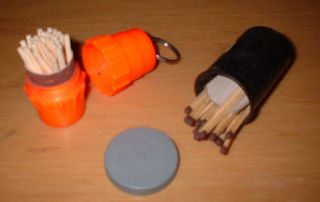
Store them in a waterproof container, an empty film can or a store bought match safe.
The matches themselves can be waterproofed by dipping the heads in melted wax (gently pry the wax of with your fingernails before use).
There are two kinds of matches; the safety match, which need a special striking surface and the strike anywhere match, matches you can use without a special striking surface.
I use the safety matches as the strike anywhere kind is not sold in Norway, but if you can get hold of some strike anywhere matches, use them.
The downside of the safety matches is that you have to strike it on the striking surface outside the box. And when packing the matches in a film can you must also pack the striking surface with them. This adds more room for mishaps.
Loose the striker in a puddle of water and your matches are useless. Or you could just ruin the surface, same result.
A little tip; glue both striking surfaces from the matchbox together, it makes the striking surface a little stiffer and more user friendly.
You could however also loose your matches in a puddle and then it doesnít matter if theyíre the safety kind or not.
Damp matches can be dried, but they will not ignite as good, if at all.
That said, Iíve been hunting, fishing and camping all my life, mostly with the matches in its original cardboard box, often soaked to the skin and never have I been unable to light a fire or my primus because the matches were wet.
Iíve always carried some matches in a waterproof container as a backup though.
The only storm matches Iíve tried are the Cyclone storm matches by Swedish match, and I donít like them.
They ďburnĒ for a long time but one canít really set fire to anything before the wood of the match catch fire, and the storm matches you will burn your fingers when that happens as there are just a centimetre of wood showing. Besides they are not water proof (testet av Lars Monsen i Villmarksboka).
Other storm matches is probably worth considering, but I never had any use for them, and Iíve lighted many fires in some pretty strong wind. The key is to shelter the flame with your hands or your body.
The paper envelope kind I wonít even evaluate. Stay away from these unless itís all you have, or youíre lighting a smoke at home. They are however good if they are the only one you have.
METALMATCH/ FERROCERIUM ROD
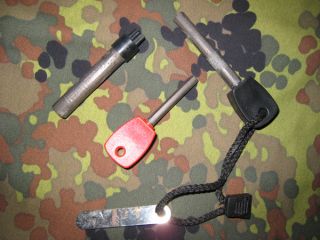
A metalmatch is easily explained a big lighter flint, the same as the flint on your BIC or zippo (picture above).
It`s used by scraping a sharp object, knife, hacksawblade or glass along the side of the flint creating sparks, or the other way around. You are less prone to spread the tinder all over with your hand if you hold the scraper still and pull the metalmatch towards you.
These sparks are hot and easily set fire to dry grass or old man`s beard (norw; skjegglav). Other tinders may also be used, like char cloth, steel wool (very fine), or tinder fungus (false and true).
Cotton balls soaked in petroleum jelly (Vaseline) works very good with the fire steel.
On the picture below I`m setting fire to some dry grass. Sadly the sparks evaded my camera :).
Try making it a habit collecting dry tinder as you walk trough the forest. It could be hard to come by when you really need it. Especially Old man`s beard.
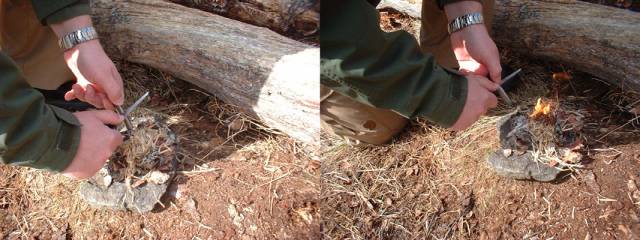
One way to make birch bark catch fire is to scrape the bark with your knife until you get a pile of birch bark dust and ignite it with your metal match.
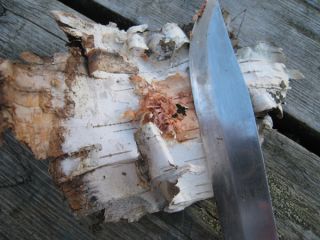
You could also use these to light your gas or alcohol stoves.
There are different sizes and styles of metalmatches but they all work in the same way. I`ve tried the Blastmatch (one handed operation) and it worked fine (I now use only the rod without the plastic housing). I own some others too, made in Sweden. I always have one with me as a backup firestarter.
They are fairly easy to use and can be used even when wet.
But a word of caution, they may corrode. Especially if they are in contact with salt water.
I had one lying in a small belt pouch when out in the rain. I tossed it in a drawer when I came home and forgot about it. Later when I looked in the pouch the sweedish fire steel (large type) had been badly corroded. It had no contact with salt water.
The fire steel was however not destroyed and still works.
LIGHTERS
Lighters are light, cheap and easy to use. And they are the best method for lighting a fire in wet weather.
There are 2 types of lighters, the gas lighter (the BIC at right) and lighters wich use petrol (the Zippo in the middle).
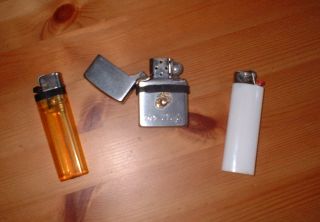
The zippo is excellent for lighting a fire. It works well in rain and fairly strong wind. The downside (IMO) is that the fuel evaporates quickly when stored and needs often refuling when in use.
The BIC lighters on the other side are not as good in rain and wind but they can be stored without fuel leaks, and they work for a long time (about 250 ingnitions I`ve heard). Just be sure to keep them close to your body in cold weather (winter) or they won`t work.
Of the two types I will choose the BIC as it`s cheap and works well. I like the transparent type as one can see how much gas that is left. When you pack your lighter it may be a good idea to put a little tape to the gas lever to prevent fuel leakage.
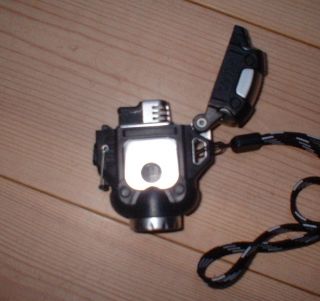
I got a storm lighter as a present from my wife, a Silva Helios (picture above). My first impression was that the lighter feels cheap.
But I`ve used it for a while now (about 2 year) and it is a nice piece of kit. It is easy to fill and very good for making fire in bad weather.
After an unintentional test in the washing machine (full cycle) the lighter has proved to be both tough and waterproof.
It is a very good lighter but I still think it is too expensive.
After using it as my pipe lighting tool I also found out that it store too little buthane to last more than a week or week and a half.
|